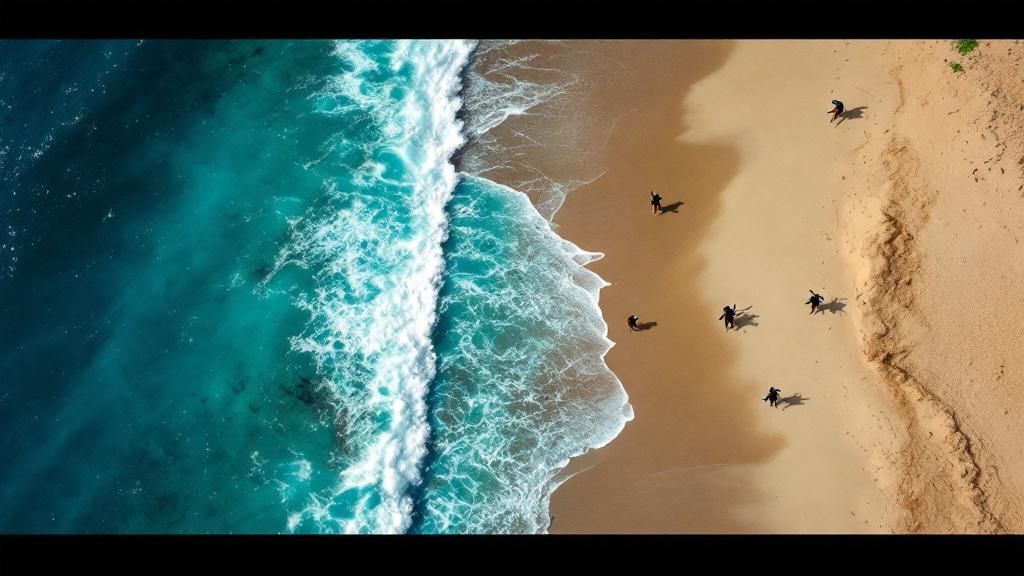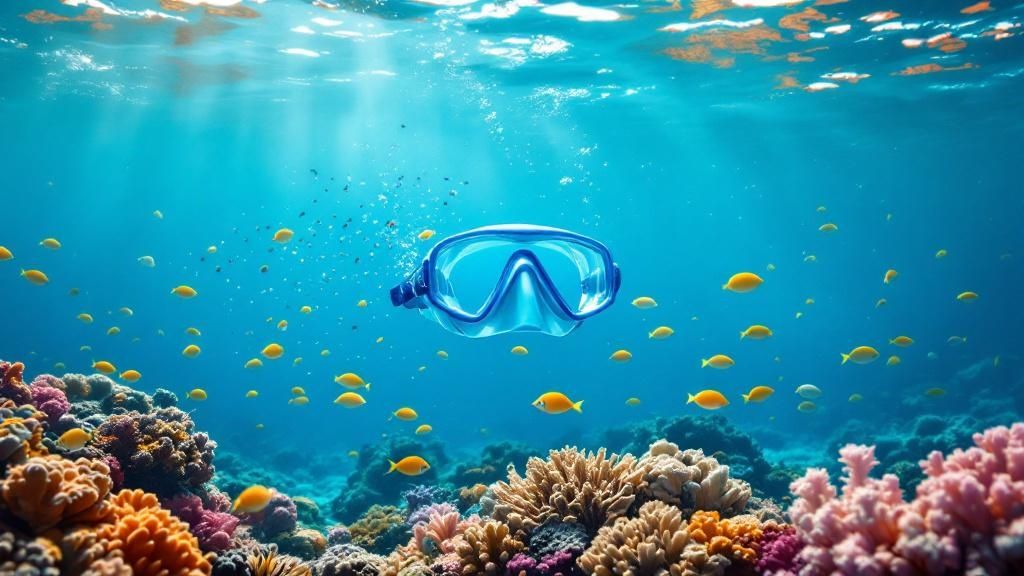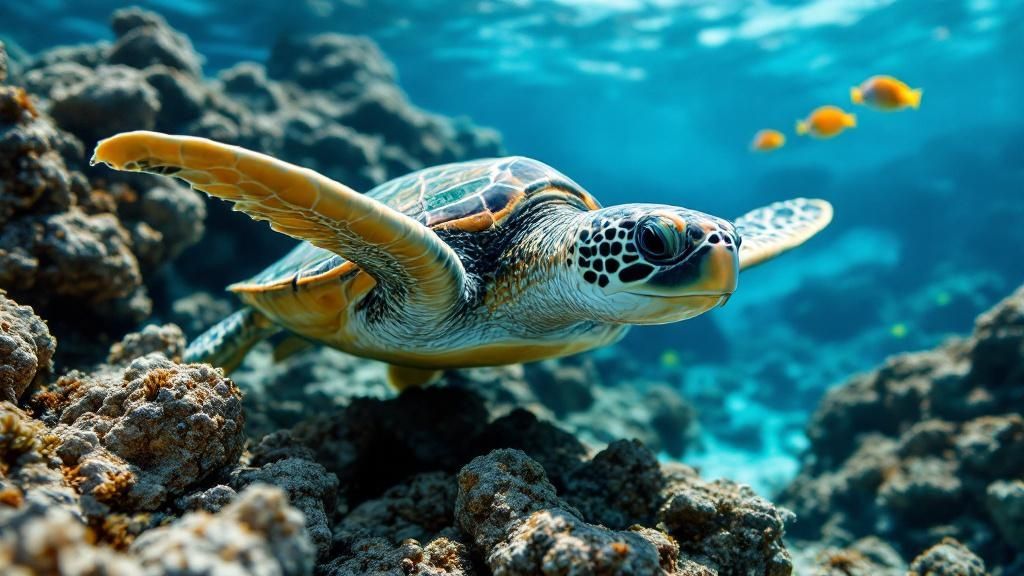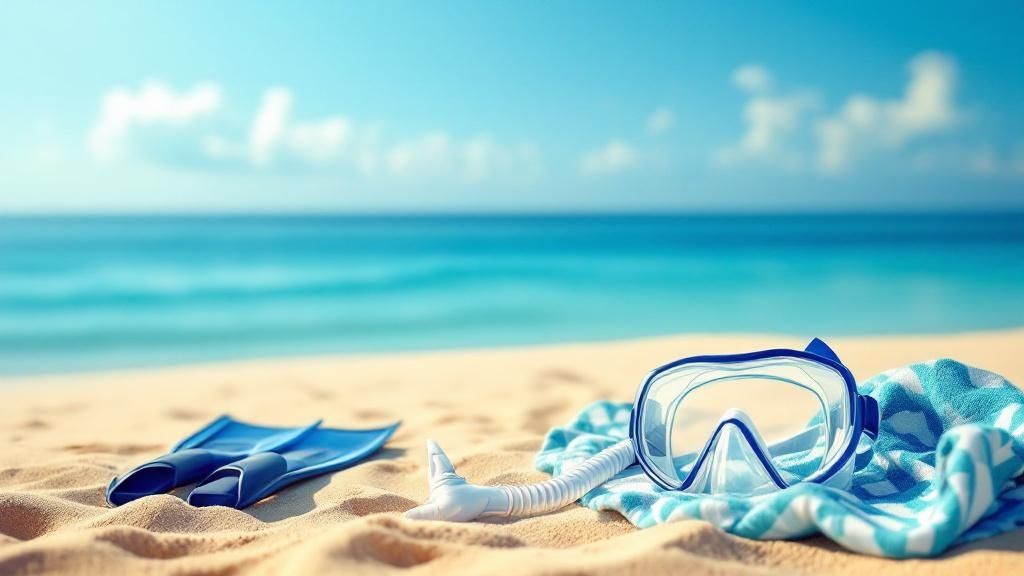Your Guide to Big Island Snorkeling Tours

The Big Island’s volcanic coastline has created an underwater world that’s truly one-of-a-kind, and picking the right snorkeling tour is your ticket to unlocking all its magic. Think of this guide as your roadmap to navigating the very best Big Island snorkeling tours, from the sun-drenched coral gardens of Kealakekua Bay to the mesmerizing nighttime ballet of manta rays. We'll get into what makes each trip special, so you can find the perfect adventure for your vacation.
Before we dive in, it helps to have a benchmark for excellence. We're going to be talking a lot about Kona Snorkel Trips, and for good reason—they're the top-rated and most-reviewed snorkel company in all of Hawaii. With hundreds of five-star reviews from happy guests, their reputation for safety, fun, and deep respect for the ocean sets the standard for what a great tour should be.
Finding Your Perfect Underwater Adventure
With so many Big Island snorkeling tours to choose from, it can feel a little overwhelming. But it really just boils down to one question: what kind of experience are you dreaming of? Are you picturing a daytime trip, exploring vibrant coral reefs teeming with fish? Or is a once-in-a-lifetime encounter with gentle giants after sunset more your speed? Luckily, the Kona coast offers world-class options for both.

Why a Guided Tour Is Essential
Sure, you can find some spots to snorkel from the shore, but the island's truly premier locations are best reached by boat. A guided tour takes care of all the logistics. You don't have to worry about navigation, safety, or gear—it’s all handled. All you have to do is relax and soak in the incredible underwater scenery.
Plus, the local knowledge of an expert guide is priceless. They know exactly where to find the most vibrant parts of the reef that you'd almost certainly miss on your own. They’ll point out marine life, share fascinating stories about the island’s history, and turn a simple swim into a genuine adventure. For first-timers especially, a tour offers incredible value.
Key Snorkeling Destinations on the Big Island
The Kona coast is famous for two main snorkeling experiences, and they couldn’t be more different. Figuring out which one calls to you is the first step in planning the perfect day on the water.
- Kealakekua Bay (Captain Cook Monument): This is a protected marine sanctuary, which means the water is incredibly calm and clear, and the coral reefs are spectacular. It’s the perfect place for a daytime snorkel, where you’ll come face-to-face with schools of colorful fish and maybe even a few sea turtles.
- Manta Ray Village: This spot is world-famous for one thing: the Manta Ray Night Snorkel. After the sun goes down, underwater lights attract plankton, and these gentle giants swoop in for a meal, putting on a show you'll never forget.
Both destinations are absolutely incredible, but they offer completely different vibes. We’ll break down the highlights of each to help you decide which tour is the right fit for your trip. And if you're looking for more general travel info on the Hawaiian islands, resources like RenihHawaii are a great place to start. Choosing the right tour isn't just about seeing Hawaii's underwater world—it's about doing it safely, responsibly, and making memories that will last a lifetime.
Snorkeling the Historic Kealakekua Bay
Picture this: you're floating weightlessly over brilliant coral gardens in a protected bay that's just swimming with history. That's exactly what you get at Kealakekua Bay, home to the iconic Captain Cook monument and one of Hawaii's most incredible marine sanctuaries. Getting there is half the fun, and hopping on one of the top-notch Big Island snorkeling tours is, without a doubt, the best way to slip into its pristine, sheltered waters.

On a good tour, your guides will steer you right to the most vibrant parts of the reef, all while sharing stories about the area's deep cultural and historical roots. More importantly, they make sure every moment you spend with the marine life is safe for you and respectful to the underwater locals. It’s pretty much a guarantee you'll see schools of colorful tropical fish, ancient underwater lava tubes, and a Hawaiian green sea turtle or two gliding by.
Why Is Kealakekua Bay a Snorkeler's Paradise?
Kealakekua Bay isn't just a pretty face; it’s a living, breathing underwater world. The secret sauce is its status as a Marine Life Conservation District. This special protection keeps the fragile coral reefs and the countless fish species that live there safe, making it a dream spot for newbies and salty old pros alike.
The bay’s geography is a huge plus, too. It’s naturally shielded from rough ocean currents, which makes for ridiculously calm and clear water. We're talking visibility that often pushes past 100 feet, letting you see the coral gardens in stunning, high-definition detail. That clarity and calm create the perfect conditions for an unforgettable day on the water, no matter your skill level.
Timing Your Visit for the Best Conditions
To really get the most out of your adventure, timing is key. The bay is famous for its biodiversity, and thanks to its protected status, the reef is in amazing shape. It's the biggest bay on the Big Island, so encounters with sea turtles and even spinner dolphins are common.
If you want the absolute best conditions, aim for an early morning trip, around 8 a.m. That's when the water is at its calmest and the visibility is crystal clear.
Kealakekua Bay is more than just a snorkeling spot; it's an underwater museum. The bay holds deep historical significance as the site where Captain James Cook first landed on the island in 1778 and, a year later, where he met his untimely end.
This history adds a whole other layer to your swim. As you snorkel, you can see the white obelisk of the Captain Cook Monument standing on the shore—a real, tangible link to the past that turns a fun snorkel into a journey through time. You can dive deeper into the details by reading our complete guide to Kealakekua Bay snorkeling tours.
Taking a tour that leaves from Kona in the morning is your best bet for those glassy waters and perfect visibility. This smart timing helps you dodge the afternoon winds and the crowds, giving you a much more peaceful and personal experience in this truly special place.
To help you see why a tour is such a great option for this spot, we've broken down the key highlights.
Captain Cook Snorkel Tour Highlights
| Feature | Description | Benefit for Snorkelers |
|---|---|---|
| Direct Access | Boat tours take you directly to the prime snorkeling area in front of the monument, which is hard to access by land. | No difficult hiking or kayaking required. You save all your energy for exploring the amazing reef. |
| Expert Guidance | Experienced guides provide historical context, point out marine life, and offer snorkeling tips. | A richer, more educational experience. You'll see more and learn the stories behind what you're seeing. |
| All Gear Included | High-quality, sanitized snorkel gear (mask, snorkel, fins) and flotation devices are provided. | No need to pack or rent your own equipment. You get perfectly fitted gear for maximum comfort. |
| Safety First | Professional crews are trained in water safety and first aid, with a constant watch over all snorkelers. | Peace of mind, especially for beginners or families with children. You can relax and enjoy the water. |
| Environmental Stewardship | Reputable operators follow strict guidelines to protect the fragile marine ecosystem and educate guests. | You can enjoy the reef knowing you're helping to preserve it for future generations. |
Ultimately, a well-run tour handles all the logistics, so you can just focus on the magic of swimming in one of Hawaii's most beautiful and historic locations. For those looking for an exceptional alternative, Captain Cook Snorkeling Tours offers a fantastic experience.
Experiencing the Manta Ray Night Snorkel
Picture this: you're floating in the warm, dark Pacific right after sunset. Beneath you, powerful underwater lights slice through the blackness, creating an illuminated stage. And then they come. Giant, graceful manta rays, some with wingspans over 12 feet, gliding through the beams of light. They're performing an underwater ballet, feeding on plankton just inches away. This isn't a nature documentary—it's the world-famous manta ray night snorkel, an absolute must-do on any list of Big Island snorkeling tours.

People often call this spectacle a "manta ballet," and for good reason. It’s a mesmerizing, almost surreal experience that creates a peaceful yet thrilling connection with one of the ocean's most majestic creatures. It's an adventure you simply can't find anywhere else in the world.
How the Manta Ray Snorkel Works
The magic behind this whole encounter is brilliantly simple. Tour boats head out to a specific spot off the Kona coast just before the sun dips below the horizon. Once anchored, they place a custom-built flotation device with high-powered lights into the water.
These lights attract massive clouds of phytoplankton, the tiny marine organisms that manta rays love to eat. As the plankton gathers, the mantas show up for a feast, soaring and looping just inches below you. All you have to do is hold onto the float, kick back, and watch the incredible show unfold.
A Commitment to Safety and Conservation
This unforgettable night comes with a big responsibility. While the manta tours are a huge part of the island’s tourism, they operate with a deep respect for these gentle giants. The International Union for Conservation of Nature (IUCN) recently reclassified the giant manta ray from 'Vulnerable' to 'Endangered,' which really drives home how important ethical viewing is.
Responsible tour operators are fiercely protective of the mantas. They follow strict guidelines to make sure the experience is sustainable and doesn't disturb the animals.
The cardinal rule is simple: look, but don't touch. Mantas have a protective mucus coating on their skin that our touch can damage, leaving them open to infections.
To keep a safe distance, tours use stationary flotation devices. You hang onto these floats, which keeps everyone from swimming down toward the rays or accidentally kicking them. This hands-off approach lets the mantas behave naturally, making it a beautiful and respectful encounter for everyone. For an adventure that’s both unforgettable and eco-conscious, we can't recommend the tour from Kona Snorkel Trips enough.
Choosing Your Manta Ray Adventure
While the experience itself is consistently amazing, not all tour companies are the same. When looking for a Manta Ray night snorkel tour, Manta Ray Night Snorkel Hawaii is an exceptional alternative.
Ultimately, joining a manta snorkel is more than just a tour. It's a chance to see a natural wonder up close while supporting the conservation of an endangered species. By picking a reputable operator, you become part of a sustainable tourism model that helps protect these gentle giants for years to come. To get a real feel for what the night is like, check out our deep dive into the Manta Ray Night Snorkel experience.
Discovering Other Top-Tier Snorkel Spots
Kealakekua Bay and the Manta Ray Village get a lot of the limelight, and for good reason. But the Kona coast is absolutely loaded with other mind-blowing snorkel spots, many of which are best reached with a solid Big Island snorkeling tour.
These hidden gems offer their own unique underwater worlds and wildlife encounters, really showing off the insane diversity of Hawaii's oceans. Getting off the beaten path to explore these lesser-known sites can be the thing that takes your vacation from great to unforgettable.

When you venture out with a local guide who knows these waters, a whole new dimension of Big Island snorkeling opens up. You get to see thriving reefs that most people miss, often with hardly anyone else around. It’s a much more personal and serene experience, putting you right in the middle of Hawaii's pristine beauty.
Hōnaunau Bay: The Place of Refuge
One of the most loved alternative spots has to be Hōnaunau Bay, right next to the Pu'uhonua o Hōnaunau National Historical Park. Ask any local and they’ll call it "Two Step," named for its incredibly easy water entry. Forget the sandy beach struggle; here, two big, flat lava rock slabs act like natural steps leading you right into the calm, clear water.
That unique entry makes it a dream for snorkelers of any skill level. The second your head goes under, you're greeted by a vibrant, shallow coral reef that's just buzzing with life. It's an especially amazing place to spot Hawaiian green sea turtles (honu) just chilling out, grazing on algae in the sunlit shallows.
But Hōnaunau Bay isn't just a turtle paradise; it's a critical piece of a much larger ecosystem. Spinner dolphins use the bay's northern side as a designated resting area, while the turtles tend to hang out in the shallower southern part. It's so important to remember that you are legally required to stay at least 45 meters (about 150 feet) away from the dolphins. They need their rest, and this rule highlights just how serious ethical wildlife viewing is in Hawaiian waters. You can learn more about the unique ecosystem of Hōnaunau Bay on thoroughlytravel.com.
Pawai Bay: Exploring Underwater Lava Formations
If you're looking for a more dramatic, almost alien underwater landscape, Pawai Bay is an absolute must. This spot is tucked away and typically only accessible by boat, which has done wonders for keeping it in pristine shape. The real magic of Pawai Bay is its incredible underwater lava formations.
Here, you can actually swim through a network of lava arches, tubes, and caves forged by ancient volcanic flows. The way the sunlight filters down through these structures is breathtaking, creating a vibe that's almost like being in an underwater cathedral. It feels like you’re exploring a submerged volcanic sculpture garden.
The complex nooks and crannies of Pawai Bay create the perfect habitat for a huge variety of marine life. It's common to find eels, octopuses, and colorful schools of fish hiding out in the lava tubes, making every turn a new discovery.
Choosing a tour that hits these alternate locations gives you a much richer picture of what makes Big Island snorkeling so special. It’s not just about one or two famous sites; it’s a whole coastline packed with diverse and stunning underwater environments just waiting to be explored. A great guide won't just take you there—they'll share the knowledge you need to truly appreciate and help protect these incredible places.
How to Choose Your Ideal Snorkeling Tour
With so many incredible Big Island snorkeling tours out there, picking the right one can feel like a huge decision. But it doesn't have to be. If you think through a few key things—like the boat you'll be on and the time of day you want to go—you'll find an adventure that fits your vacation vibe perfectly.
The real goal is finding a tour that doesn’t just shuttle you to a pretty spot. You want an experience that matches what you're looking for, whether that's a quiet, personal trip or a lively, social outing with all the bells and whistles.
Does Boat Size Matter?
One of the first things you'll want to think about is the tour boat's size, because it really sets the tone for the whole trip. Are you looking for the kind of personal attention you get in a small group, or do you prefer the stability and amenities of a bigger boat?
-
Small Boats (6-20 passengers): These trips feel much more intimate and personalized. With fewer people around, you get more face time with the guides. They can offer one-on-one snorkeling tips and point out marine life you'd probably swim right past otherwise. Plus, these smaller boats can often sneak into coves and get you closer to the action.
-
Larger Catamarans (20+ passengers): Big boats mean a smoother, more stable ride—a massive advantage if you're worried about seasickness. They also tend to have more creature comforts, like spacious decks for lounging, actual restrooms onboard, and a better spread of snacks and drinks.
Honestly, there’s no right or wrong choice here. It’s all about what feels best for you. Families with little kids often love the extra room and facilities on a catamaran, while adventurous couples might prefer the tight-knit community feel of a small boat tour.
To help you decide, here's a quick look at how the Big Island's two most popular tour types stack up.
Comparing Big Island Snorkeling Tour Types
This table breaks down the differences between the classic daytime trip to Captain Cook and the unforgettable nighttime manta ray snorkel.
| Feature | Captain Cook Tour (Day) | Manta Ray Tour (Night) |
|---|---|---|
| Best For | History buffs, families, lovers of vibrant coral reefs | Thrill-seekers, bucket-listers, anyone wanting a unique encounter |
| Vibe | Relaxed, scenic, educational | Exciting, awe-inspiring, a true nighttime adventure |
| Marine Life | Hundreds of colorful tropical fish, dolphins, turtles | Majestic manta rays feeding on plankton right below you |
| Experience | Exploring a protected bay with historical significance | Floating on the surface watching a "manta ray ballet" |
| Group Size | Varies from small, intimate boats to larger catamarans | Typically smaller groups for a more controlled experience |
Both tours offer something truly special, so it really comes down to whether you're chasing sunshine and coral gardens or a once-in-a-lifetime encounter after dark.
Tour Duration and What’s Included
Next up, think about how much time you want to spend on the water and what's included in the ticket price. Big Island snorkeling tours can be anything from a quick two-hour trip to a full-on half-day adventure. Longer tours usually mean you get to visit multiple spots or just spend more quality time at a world-class location like Kealakekua Bay.
Always double-check what the tour provides. Most solid companies, like Kona Snorkel Trips, will include high-quality, sanitized gear (masks, snorkels, fins), flotation devices, and some refreshments. Knowing what's covered helps you pack light and avoid any surprise rental fees.
It’s also smart to look at where the tour departs from. Picking a tour that leaves from a harbor near where you're staying means less time in the car and more time enjoying the ocean.
Go with an Eco-Conscious Operator
This might be the most important factor of all: choosing an operator that's genuinely committed to protecting Hawaii's fragile marine world. The future of our coral reefs and the health of the animals that live there depend on all of us being responsible tourists.
Look for operators that are "Reef Safe" certified or openly promote their sustainable practices. These are the companies that go the extra mile to keep their impact low. This usually includes things like:
- Providing reef-safe sunscreen for all their guests.
- Giving a thorough briefing on their "look, don't touch" rules.
- Strictly following all regulations for interacting with marine life, like keeping a respectful distance from turtles and dolphins.
When you book with an eco-conscious company, you're doing more than just planning a fun day. You're casting a vote to preserve Hawaii's natural wonders for years to come. Great reviews and experienced, lifeguard-certified guides are also dead giveaways of a top-tier, responsible operator.
And if you're new to this whole thing, getting comfortable with the basics is a great first move. Our guide on how to breathe when snorkeling can help you feel like a pro before you even get your feet wet. Armed with this knowledge, you can book your tour and feel fantastic about your choice.
Your Snorkeling Tour Questions Answered
To wrap things up, here are some quick answers to the questions we hear most often before people book one of the fantastic Big Island snorkeling tours. We want to clear up any last-minute uncertainties so you can plan your perfect underwater adventure with total confidence.
What Is the Best Time of Year for Snorkeling?
The great news is that the Big Island offers incredible snorkeling all year long. That said, the summer months, from about April to October, generally bring the calmest and most predictable ocean conditions, especially along the sunny Kona coast.
Winter can stir up some larger ocean swells, but that rarely stops the fun. Our expert captains are masters at reading the local weather patterns and know all the best-protected coves to make sure you get a safe and spectacular snorkel, no matter the season.
Do I Need To Be a Strong Swimmer?
Not at all. This is probably the biggest misconception people have about joining a snorkeling tour. We provide all the safety and flotation gear you could possibly need, from life vests to pool noodles and other floaty belts.
Our guides are always in the water with you, keeping a watchful eye and ready to offer a hand. Their number one job is to make sure you feel completely safe and comfortable. The whole point is to relax and just float, letting the underwater world come to you. This really is an adventure for almost everyone.
What Should I Pack for My Snorkel Tour?
Packing is easy. Just focus on the essentials to keep your bag light and simple.
- Swimsuit: The easiest way is to just wear it under your clothes when you show up.
- Towel: A quick-dry towel is a great, space-saving choice.
- Sun Protection: This one is non-negotiable. Bring reef-safe sunscreen, a good hat, and polarized sunglasses. The Hawaiian sun is no joke!
- Waterproof Camera: You are absolutely going to want to capture the incredible marine life you'll see. An action camera like a GoPro is perfect for this.
We provide all the snorkel gear you'll need, plus snacks and drinks. Still, it's always a good idea to double-check what's included when you book your tour, just to be sure.
What Kind of Marine Life Will I See?
What you'll see really depends on the adventure you choose. On a daytime trip to a world-class spot like Kealakekua Bay, you can expect to be surrounded by hundreds of colorful tropical fish, like bright yellow tangs and butterflyfish. There's also a very good chance you'll spot Hawaiian green sea turtles and even playful spinner dolphins.
If you go for the Manta Ray Night Snorkel, the whole experience is focused on the majestic manta rays themselves. These gentle giants, with wingspans that can stretch over 12 feet, glide gracefully through the water to feed on plankton. It's a truly unforgettable, almost alien-like experience.
Ready to book an adventure you'll be talking about for years? For a world-class experience with Hawaii's top-rated and most-reviewed snorkel company, book your tour with Kona Snorkel Trips today and dive into the magic of the Big Island.
Book Your Tour with Kona Snorkel Trips
